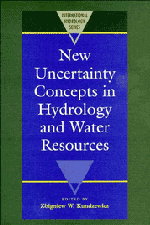Book contents
- Frontmatter
- Contents
- List of Authors
- Preface
- I INTRODUCTION
- II FACETS OF UNCERTAINTY
- III NOVEL APPROACHES TO UNCERTAINTY: FRACTALS, FUZZY SETS AND PATTERN RECOGNITION, NON-PARAMETRIC METHODS
- 1 Dispersion in stratified soils with fractal permeability distribution
- 2 Multifractals and rain
- 3 Is rain fractal?
- 4 Multifractal structure of rainfall occurrence in West Africa
- 5 Analysis of high-resolution rainfall data
- 6 Application of fuzzy theory to snowmelt runoff
- 7 On the value of fuzzy concepts in hydrology and water resources management
- 8 Application of neural network in groundwater remediation under conditions of uncertainty
- 9 Application of pattern recognition to rainfall–runoff analysis
- 10 Nonparametric estimation of multivariate density and nonparametric regression
- 11 Nonparametric approach to design flood estimation with pre-gauging data and information
- IV RANDOM FIELDS
- V TIME SERIES AND STOCHASTIC PROCESSES
- VI RISK, RELIABILITY AND RELATED CRITERIA
2 - Multifractals and rain
Published online by Cambridge University Press: 07 May 2010
- Frontmatter
- Contents
- List of Authors
- Preface
- I INTRODUCTION
- II FACETS OF UNCERTAINTY
- III NOVEL APPROACHES TO UNCERTAINTY: FRACTALS, FUZZY SETS AND PATTERN RECOGNITION, NON-PARAMETRIC METHODS
- 1 Dispersion in stratified soils with fractal permeability distribution
- 2 Multifractals and rain
- 3 Is rain fractal?
- 4 Multifractal structure of rainfall occurrence in West Africa
- 5 Analysis of high-resolution rainfall data
- 6 Application of fuzzy theory to snowmelt runoff
- 7 On the value of fuzzy concepts in hydrology and water resources management
- 8 Application of neural network in groundwater remediation under conditions of uncertainty
- 9 Application of pattern recognition to rainfall–runoff analysis
- 10 Nonparametric estimation of multivariate density and nonparametric regression
- 11 Nonparametric approach to design flood estimation with pre-gauging data and information
- IV RANDOM FIELDS
- V TIME SERIES AND STOCHASTIC PROCESSES
- VI RISK, RELIABILITY AND RELATED CRITERIA
Summary
ABSTRACT Scaling models and analyses of rain have now been around for over ten years, a period in which the corresponding scale invariant notions have seen rapid development. We review these developments concentrating on multifractals that are believed to provide the appropriate theoretical framework for scaling nonlinear dynamical systems. Although early scaling notions were geometric rather than dynamic, they contributed towards establishing and testing scaling ideas in rain and in determining the limits of scaling in both time and space. The problematic of passive scalar clouds and (continuous) turbulent cascades, provided them with a sound physical basis. Building on these advances, later analysis methods (particularly Double Trace Moment technique) made it possible to obtain robust estimates of the basic multifractal parameters. Continuous (and universal) cascades allow us to exploit these parameters to make dynamical models. We also discuss various applications of multifractals to rain including multifractal objective analysis, statistics of extreme values, multifractal modelling, space-time transformations, the multifractal radar observer's problem, stratification, and texture of rain.
INTRODUCTION
Stochastic models of rain, atmospheric scaling and multifractals
The atmosphere is probably the most familiar highly nonlinear dynamical system; the nonlinear terms are roughly ≈1012 (the Reynolds number) times larger than the linear (dissipation) terms, and structures vary over 9–10 orders of magnitude in space (≈ 1 mm to 104 km) and at least as much in time (≈10−3 s on up).
- Type
- Chapter
- Information
- New Uncertainty Concepts in Hydrology and Water Resources , pp. 61 - 103Publisher: Cambridge University PressPrint publication year: 1995
- 80
- Cited by

